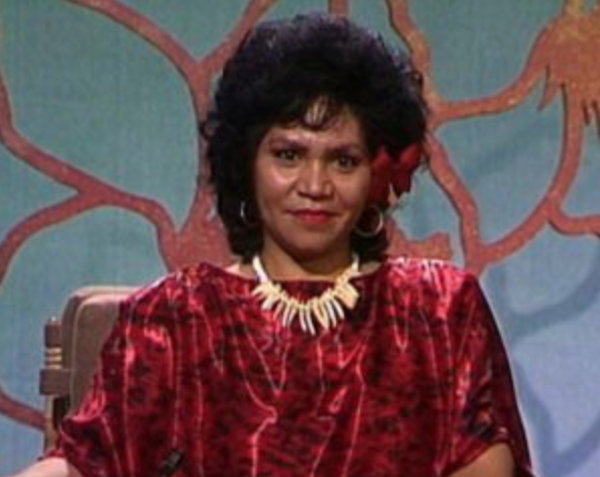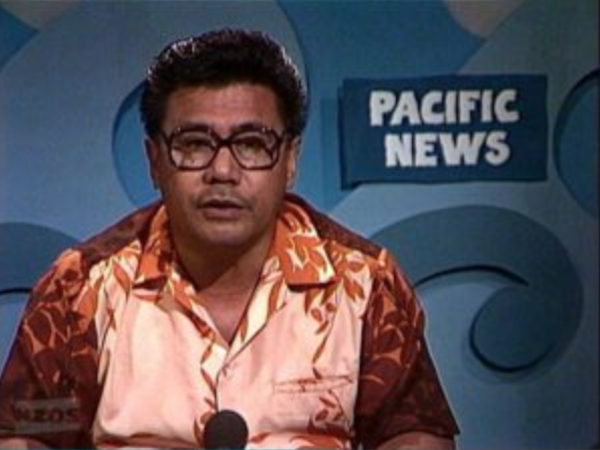Tagata Pasifika is celebrating 35 years on air this year. Former hosts Foufou Susana Hukui, Reverend Elder Maligi Evile and former researcher/reporter Iulia Leilua take look back at the early days. Video: Sunpix
By John Pulu of Tagata Pasifika
A trip down memory lane for Tagata Pasifika’s first host, Foufou Susana Hukui as she watches a video clip of an interview she did with former Prime Minister of Samoa, Tupua Tamasese Efi.
“It was just the most exciting journey that we were going to take,” Hukui says.
“Because I have watched the white man, white people, other people but never us telling our own stories. When they were told, they were told from a white man’s perspective.”

The weekly show first aired on the 4 April 1987, as a pan-Pacific voice on New Zealand television.
“When I got on our first programme, I made sure that we were different. I didn’t deliberately do it — that’s just the way I was,” Hukui says.
“Coloured clothes, summer right through the whole year and flowers in my ear. I just wanted people to know who I was, this is me and this is going to be our people’s programme.”
Hukui switched from working in radio to pioneer storytelling from a Pasifika lens on national television covering a myriad of stories and events.

‘Flooded the market with colour’
“We did suddenly flood the market on the media with colour that we are used to with flowers, with headgear, with cooking, the puaka, hair cutting ceremonies, weddings; and this, you know, even though it’s our culture, we love to see it on TV.
“In those days we didn’t have social media so we were, at the time, just right because that was the strongest medium at the time,” Hukui says.
From the very start, Tagata Pasifika was a news and information show for the community.
Radio broadcasters like the Reverend Maligi Evile played a key role as the first news reader.
“The programme was more or less bifocal in the sense that I was telling our people what is happening out there at home in your country and your home and I was also telling the NZ public, the NZ community that this is what is happening out there in our homes in the Pacific,” Reverend Evile says.
As our people continued to come to Aotearoa, the half hour show played an important role in helping them settle in and feel like they belonged here.
“I was really appreciative to think that, considering the number of Pacific people who were living in NZ at the time, I think it’s about time that we have some small window on the screen on TVNZ,” he says.
‘Transforming a window’
“When this opportunity came along, I thought this was the window that we were waiting for and I was hoping that this window will transform into a door and perhaps into a room and even a big house for bigger things to come for the Pacific people.”

And over the years Tagata Pasifika has moved through different time slots and faces have come and gone, but through it all viewers have remained loyal.
Former researcher and reporter Iulia Leilua says there was a demand for Pacific voices and faces to be seen and heard in the media following major events like the Dawn Raids which happened in the previous decade.
“I thank TVNZ for their foresight, I thank even more so the people who lobbied for this programme. TVNZ really had no option but to showcase the Māori and Pacific voice and faces at that time,” Leilua says.
In 2014, TVNZ announced that the show will no longer be made in-house and the following year production company Sunpix Limited started producing the show.
“Tagata Pasifika is reflective of our Pacific peoples and it’s been there on that journey for many people and their lives. People come to the show to see stories that they are not hearing or seeing elsewhere so the legacy is kind of this, you know, this trusted source of story telling about our people and an important place that documents our people’s lives and history,” Leilua says.

Playing a role online
Now, 35 years on, with a wide variety of media to choose from Tagata Pasifika continues to play a role not just on our television screens but also online where more content is available. But there has always been a dream for more time on air.
“We started off with half an hour, perhaps give us another 15 mins on air or perhaps give us an extra half hour you know we need a bit more frequency on air and we need more support,” Reverend Evile says.
Hukui acknowledges the changing media landscape but adds that it is even more important than ever to have a trusted source of information.
“No matter what, no matter if you have Instagram, your TikTok, whatever, Facebook, the people of our Pacific always go to what’s Tagata Pasifika to see the real, to get the real story.”
John Pulu — “JP” — is a Tagata Pasifika reporter/director/presenter and a Pacific community broadcaster.
This post was originally published on Asia Pacific Report.